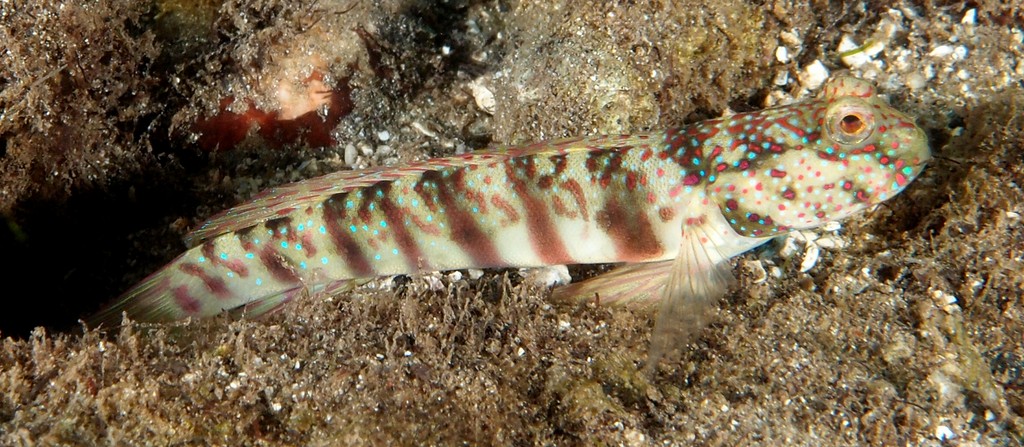CRYPTOCENTRUS LEPTOCEPHALUS - (BLEEKER, 1876)
Actinopterygii (Gigaclass) > Actinopteri (Class) > Teleostei (Subclass) > Gobiiformes (Order) > Gobioidei (Suborder) > Gobiidae (Family) > Gobiinae (Subfamily) > Cryptocentrus (Genus)
Gobie moucheté rose et bleu, Gobie à crevette rose-moucheté, Gobie à points roses, Leptocephalus prawn-goby, Pink-speckled shrimpgoby, Pink spotted watchman goby, Pinkspotted shrimp goby, Blue-spotted shrimp goby, Singapore prawn-goby, Singapore shrimp-goby, 小头丝鰕虎鱼,
Synonymes
Cryptocentrus geniornatus (Herre, 1935)
Cryptocentrus obliquus (Herre, 1934)
Smilogobius obliquus (Herre, 1934)
Smilogobius singapurensis (Herre, 1936)
---------------------------------------
Description
Dorsal spines (total): 6-7; Dorsal soft rays (total): 10-11; Anal spines: 1; Anal soft rays: 10-11; Pectoral fin rays: 17; Longitudinal scale series: 77-92; Greatest depth of body: 5.4-6.0 in SL. Body elongate, compressed. Head slightly compressed; Jaws subequal, not reaching to a vertical through posterior margin of eye; Gill opening reaching anteriorly around a vertical through posterior margin of preopercle. Pelvic fins united medially; Frenum present. Scales cycloid or weak ctenoid; Head, breast and pectoral-fin base naked. Sensory canals and pores present on head; Distinct transverse sensory-papillae rows on cheek; A pair of short longitudinal sensory papillae rows just behind chin. Rounded caudal fin, longer than head length. Max. length: 12.0 cm SL. Depth range: 0 - 18 m.
Color
Body brownish-green, becoming whitish ventrally; Six-seven diffuse brownish bars on side; Head, back and dorsal fins with pale-edged pink to red spots and smaller white spots; First dorsal fin with blue-edged orange to brown spots.
Etymology
Cryptocentrus: from Greek, kryptos = hidden + from Greek, kentron = sting. Referring to a concealed point or projection on preopercle.
leptocephalus: from Greek, lepto-, = thin, slight, fine + from Greek, -kephalos = head. Referring to its width which is 2/3 of its length.
Original description: Cryptocentrus leptocephalus Bleeker, 1876 - Type locality: Singapore.
Distribution
Western Pacific: Indonesia east to Philippines and Tonga, north to Yaeyama Islands (Japan), south to northern Australia and New Caledonia.
Biology
Found on silty bottoms of coastal reefs and inner reef flats. Inhabits coastal waters, including mangroves, large tidal pools or inner reef lagoons, on sand and rubble substrates. Symbiotically associates with alpheid shrimps.
Similar species
Cryptocentrus caeruleomaculatus (Herre, 1933) - Reported from New Caledonia - Link to the species (here).
Gobie moucheté rose et bleu, Gobie à crevette rose-moucheté, Gobie à points roses, Leptocephalus prawn-goby, Pink-speckled shrimpgoby, Pink spotted watchman goby, Pinkspotted shrimp goby, Blue-spotted shrimp goby, Singapore prawn-goby, Singapore shrimp-goby, 小头丝鰕虎鱼,
Synonymes
Cryptocentrus geniornatus (Herre, 1935)
Cryptocentrus obliquus (Herre, 1934)
Smilogobius obliquus (Herre, 1934)
Smilogobius singapurensis (Herre, 1936)
---------------------------------------
Description
Dorsal spines (total): 6-7; Dorsal soft rays (total): 10-11; Anal spines: 1; Anal soft rays: 10-11; Pectoral fin rays: 17; Longitudinal scale series: 77-92; Greatest depth of body: 5.4-6.0 in SL. Body elongate, compressed. Head slightly compressed; Jaws subequal, not reaching to a vertical through posterior margin of eye; Gill opening reaching anteriorly around a vertical through posterior margin of preopercle. Pelvic fins united medially; Frenum present. Scales cycloid or weak ctenoid; Head, breast and pectoral-fin base naked. Sensory canals and pores present on head; Distinct transverse sensory-papillae rows on cheek; A pair of short longitudinal sensory papillae rows just behind chin. Rounded caudal fin, longer than head length. Max. length: 12.0 cm SL. Depth range: 0 - 18 m.
Color
Body brownish-green, becoming whitish ventrally; Six-seven diffuse brownish bars on side; Head, back and dorsal fins with pale-edged pink to red spots and smaller white spots; First dorsal fin with blue-edged orange to brown spots.
Etymology
Cryptocentrus: from Greek, kryptos = hidden + from Greek, kentron = sting. Referring to a concealed point or projection on preopercle.
leptocephalus: from Greek, lepto-, = thin, slight, fine + from Greek, -kephalos = head. Referring to its width which is 2/3 of its length.
Original description: Cryptocentrus leptocephalus Bleeker, 1876 - Type locality: Singapore.
Distribution
Western Pacific: Indonesia east to Philippines and Tonga, north to Yaeyama Islands (Japan), south to northern Australia and New Caledonia.
Biology
Found on silty bottoms of coastal reefs and inner reef flats. Inhabits coastal waters, including mangroves, large tidal pools or inner reef lagoons, on sand and rubble substrates. Symbiotically associates with alpheid shrimps.
Similar species
Cryptocentrus caeruleomaculatus (Herre, 1933) - Reported from New Caledonia - Link to the species (here).
Cryptocentrus melanopus (Bleeker, 1860) - Reported from Eastern Indian Ocean and western Pacific: Singapore, Malaysia, Brunei, Vietnam, Indonesia and Australia.
